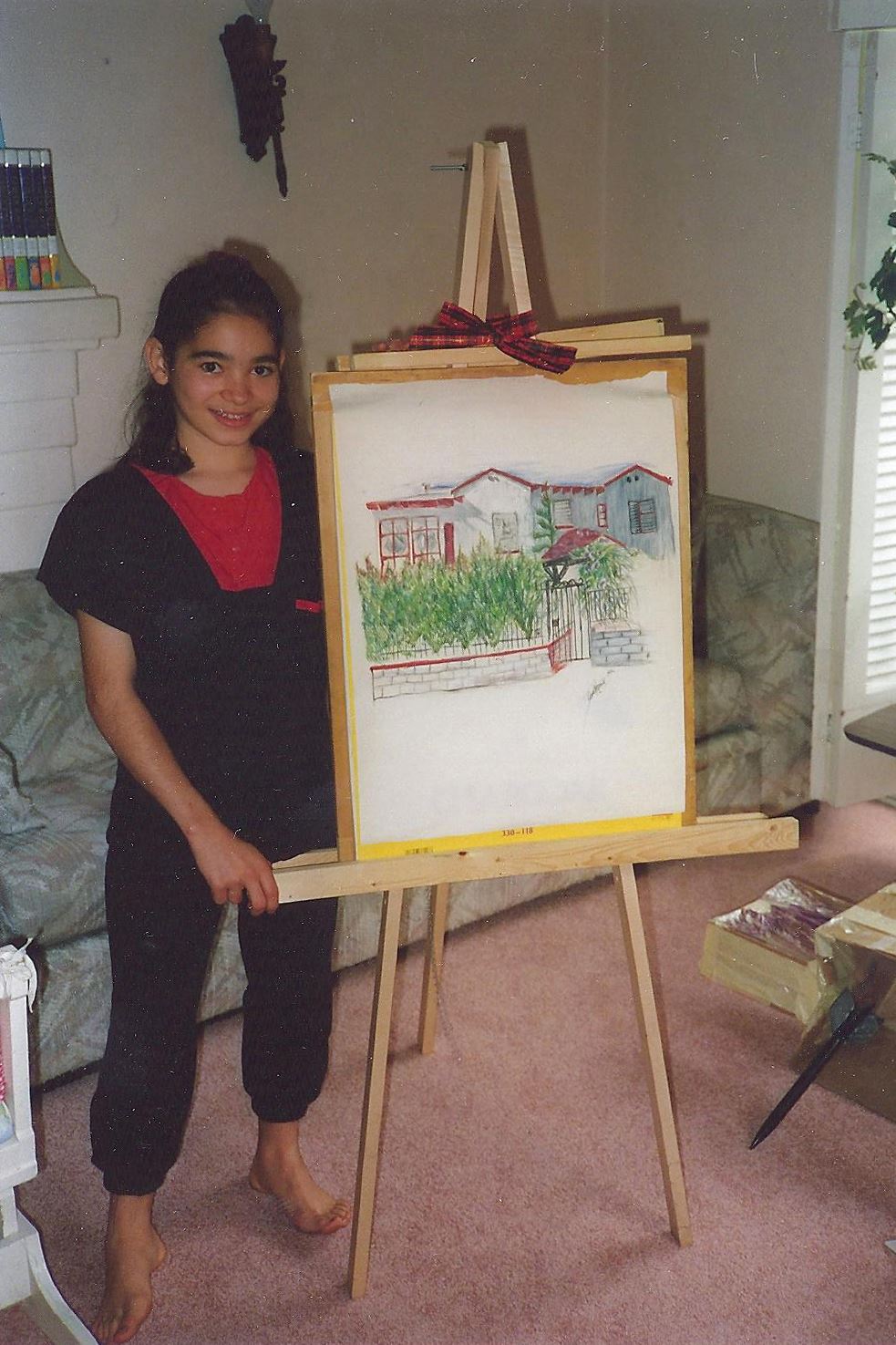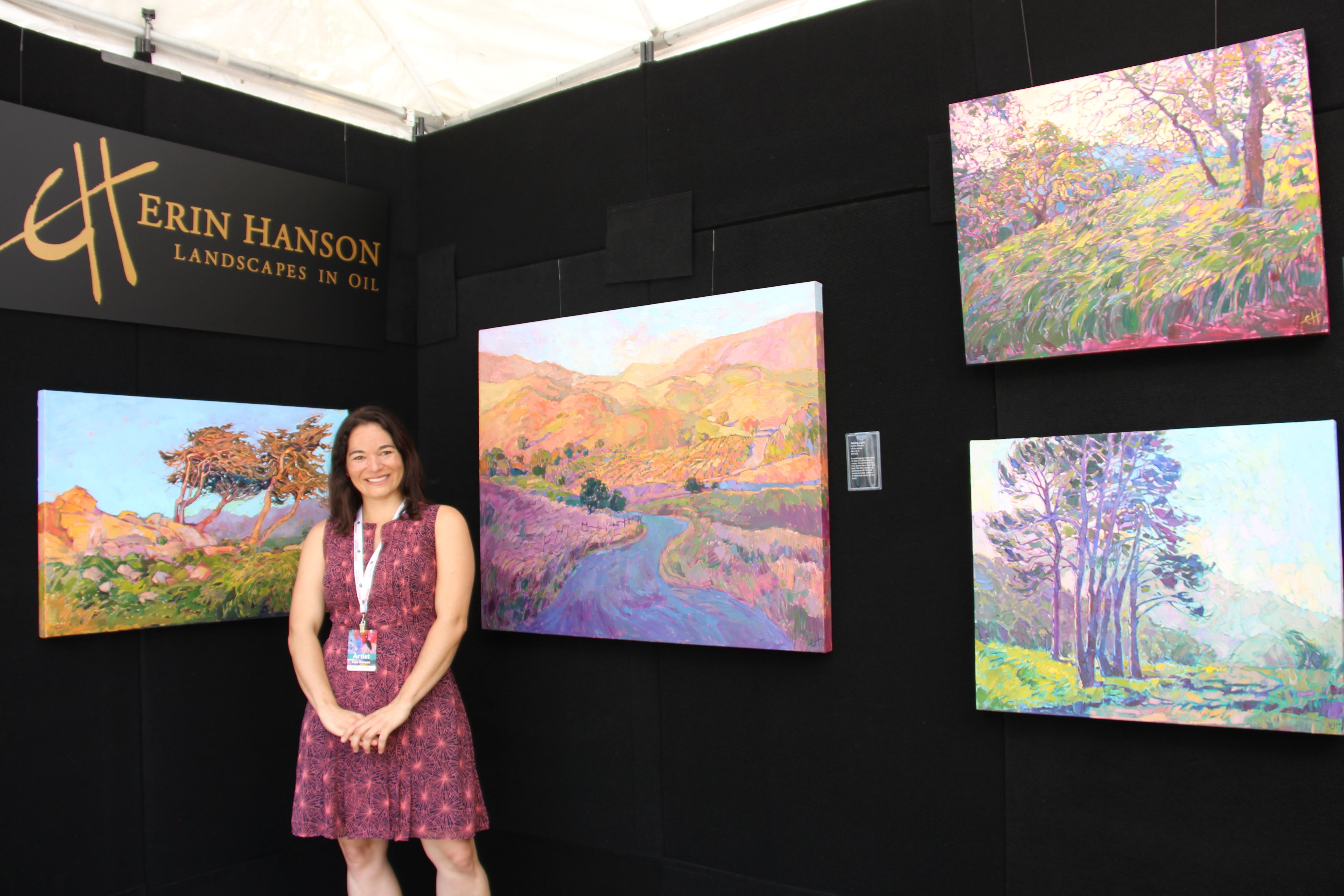
Code NEWYEAR applied for 20% off!

Subtotal
$0
U.S. Shipping
FREE
Saved for Later
Shopping Cart

Code NEWYEAR applied for 20% off!

Subtotal
$0
U.S. Shipping
FREE
Saved for Later
Alina Fridman of the “Ladies Take the Lead” podcast talked to Erin Hanson in an interview covering everything from Erin’s growth as an entrepreneur to her style and admirable work ethic. This article shares some of the interview highlights. The complete interview is available here.
Erin is well known in art circles for creating a painting every week, rain or shine. She launched the #FreshOffTheEasel hashtag on Instagram and elsewhere because of her extremely high production rate.
In previous interviews, Erin has discussed her pace as being inspired by her father. He encouraged her to develop her talent by creating art every single day, thereby perfecting her skills and practicing techniques. From that philosophy of learning by doing came her pledge to create a painting a week. This is something she has done for over a decade now, with no signs of slowing. Here’s what she has to say about the decision to create a complete painting every week:
“I decided to start creating a painting a week when I started climbing in Las Vegas. I grew up in Los Angeles and when I saw Red Rock Canyon for the first time, it was the most beautiful landscape I’d ever seen. I was just endlessly inspired. Every morning I went out rock climbing and saw the sunrise hitting bright red, yellow, and orange cliffs. It was just so much more interesting to paint than city life or chaparral or scrubby little trees. It was much more inspiring to be out in the wide-open desert with big skies and dramatic colors. I decided to create a unique impressionistic style to capture what I was seeing.” - Erin Hanson

Erin is primarily known for her open impressionism. This is a style of contemporary impressionism that features bold brushstrokes and vibrant color. It is best described as an homage to the impressionism of the past, with a nod to modern expressionism, using a plein-air-style technique.
Erin talks more about her technique and her process in the interview:
“When I got into painting regularly as an adult, I invented a unique technique of painting in oils where I premix my entire palette and pre-plan my paintings before I ever pick up a brush. So, when it’s actually time to paint, every single color that will appear in the painting is already pre-mixed on my palette. This allows me to work very quickly without layering. So, I’m placing the brushstrokes side-by-side instead of overlapping them and building up color in that way, instead of the more traditional way of painting in oils.
“By contrast, my style is more immediate, more highly textured, more exciting. It has a stained glass or mosaic appearance as opposed to the more blended, smooth look that you usually see in oil paintings.…”
“I like to think of my paintings as reverse engineering them from my mental concept. I work backwards from there to the initial starting steps.” - Erin Hanson
There is additional technical information about open impressionism, Erin’s inspirations, and more in the interview.

To combat the notion of the “starving artist,” Erin took a proactive approach to earning her living. She began her first business by buying foreclosed storage units and selling the contents. This funded her dream of becoming a full-time artist.
“I was doing ‘Storage Wars’ way before that show even came out.”
In the interview, Erin describes bidding for storage units, loading and unloading the units, and selling the items at swap meets, eBay, and Craigslist - all with her signature tenacity.
The release of the “Storage Wars” show and the subsequent competition that it brought to her business is what led Erin to Las Vegas and her beloved red rocks. She began rock climbing and painting, showing that same tenacity when completing a piece of art every week.
“When I started in the art business, what I had to do was art festivals. Which to me was like, ‘Oh! It’s a swap meet.’ It’s waking up at 4 AM, it’s lugging a bunch of heavy equipment around, setting up tables in the dark. I’m like ‘I do this every weekend! This is no big deal.’
“So, it was funny. It was such a smooth transition to go from being in the eBay world and the swap meet world, switching over to art.…”
“One of the first things I had to do was make a website. So, I had a book and I learned HTML and I designed a website. It took me a weekend - it wasn’t that hard. But, I felt like my life as an artist was very adventurous at the beginning.
“I had to teach myself framing, I bought a miter saw and I bought a bunch of molding and I was doing my own framing.
“I had to learn publishing. I published my own book through Blurb a few years in and now I have four books published and my own magazine and several flipbooks of my work. These are all great promotional tools.”
Erin goes on to talk about how art festivals had an incredible impact on her business, allowing her to spread the word - and her paintings - around the U.S.

When Erin Hanson was emerging as an artist to watch, she met most of her collectors at art festivals. The art festival as the launching pad has been vital to so many professional artists, allowing them to connect with aficionados and - equally as important - connect with their colleagues in the art world.
“Art festivals are the best way for artists to make a living in this day and age. I have personally known hundreds of artists who make a living - full time, as professional artists - by doing the art festival circuit.
“These are artists who support their families with their own art. It’s like a dream come true.…”
“Art festivals are great because they let artists take the business of selling art into their own hands. It’s kind of a two-pronged success because, on the one hand you are forced to create art. If you know you have a show in two weeks, that means you have to paint. It’s the act of painting that makes you better as an artist. The more paintings you make, the better an artist you’ll be.
“The other benefit is you learn how to sell your art. Instead of relying on a gallery to do that for you, you learn the terminology, the words, the phrases that get people excited. You learn how to describe your work, you learn what is it about your work that people respond to - what sells.
“If you’re just working through a gallery, you never get to learn any of that.”
The demands of the festival circuit allowed Erin to become prolific - and connect with collectors and artists on a personal level. She took these lessons to heart as she grew her gallery and art business
The “Ladies Take the Lead” interview goes in-depth into the marketing techniques that have made Erin a success. Erin Hanson’s works can be found around the world in embassies, national park museums, art museums, and private collections. Listen to the full podcast to learn more about how she has grown into such a success - both due to technical skill and business savvy.
Here’s a brief glimpse into what Erin had to say about marketing her artwork:
“I’ve been marketing my work for over a decade now. At the beginning, the first five to six years, the only marketing that I did was doing art festivals. But I always got everyone’s information - so when I would sell a painting or a print to someone, I would get their email and their address, which a lot of artists don’t do. I try to tell artists to do that because people who have already bought something from you are the easiest people to market to.
“I do weekly email newsletters. I send out brochures, postcards, and event invitations out in the mail every three or four months. I have a new magazine called The Impressionist, and we’ve already sent out close to 50,000 copies. I send a book to everyone who’s ever purchased a painting from me.
“I have endless ways that I’ve marketed myself over the years, but the primary source was always art festivals. There’s something about seeing art face-to-face.”
Listen to the full discussion to learn more.

Erin has taken on the 3-D scanning and printing of her paintings. This process is highly technical but endlessly fascinating. In the interview, Erin briefly describes the 3-D printing process. You can learn more about her 3-D Textured Replicas here.
“I’ve helped what’s called 3-D Printing. You’re probably familiar with 3D Printing, these machines that spit out coils of plastic and they make these little 3-D forms. There’s a printer that will do layers and layers of micro layered ink that builds up and ends up looking almost exactly like an original oil painting.
“It is an incredible new technology, so I bought this $180,000 scanner to scan my paintings and I’m about to start a lease on a $350,000 printer. These are numbers that most artists wouldn’t be able to throw around, you know?
“I’m doing it because there’s such a demand for textured artwork - especially in my paintings because oil paintings are very highly textured - and this is the first technology I’ve seen that actually captures the actual texture of artwork without looking hokey and cheesy.
“That’s something I actually just launched during COVID and it’s been a huge increase to my income because I’m able to sell this middle price-point between my canvas prints and my original oil paintings.”
Access videos and more background information on how we create Erin Hanson’s 3D Textured Replicas here - and explore the currently available limited edition 3D replicas here.

Erin Hanson’s open impressionism technique has inspired an art movement across the globe. She is proud to be at the forefront of contemporary impressionism.
“I am continuing the legacy of impressionism in the contemporary art world and I’m trying to inspire a new movement of impressionism. I have tens of thousands of artists who are copying my work and trying to emulate my style, so I really believe I am creating a new movement of impressionism, and it’s exciting!” - Erin Hanson
Learn more about Erin’s open impressionism and explore her original artwork here.
Discover the artist at the forefront of modern impressionism.

About Erin
ERIN HANSON has been painting in oils since she was 8 years old. As a teenager, she apprenticed at a mural studio where she worked on 40-foot-long paintings while selling art commissions on the side. After being told it was too hard to make a living as an artist, she got her degree in Bioengineering from UC Berkeley. Afterward, Erin became a rock climber at Red Rock Canyon, Nevada. Inspired by the colorful scenery she was climbing, she decided to return to her love of painting and create one new painting every week.
She has stuck to that decision, becoming one of the most prolific artists in history, with over 3,000 oil paintings sold to eager collectors. Erin Hanson’s style is known as "Open Impressionism" and is taught in art schools worldwide. With millions of followers, Hanson has become an iconic, driving force in the rebirth of impressionism, inspiring thousands of other artists to pick up the brush.